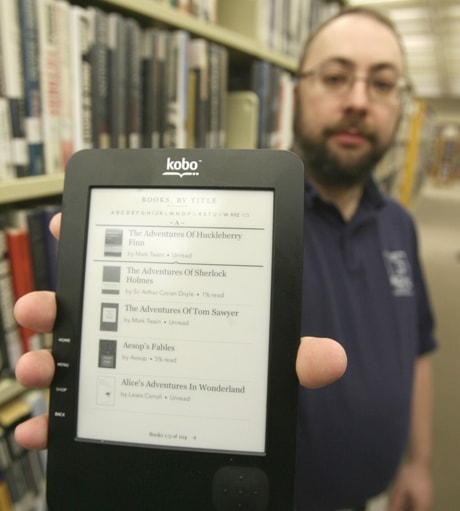One of the oldest forms of portable entertainment has finally entered the digital age, and that has literature lovers split.
The emergence of the electronic book is stoking fear for the integrity of the novel as an art form.
But the e-book has others heralding a new frontier in literature.
“People are reacting drastically, instead of taking a step back and realizing these are just growing pains until we hit that point of maturity and know how we fit into each other’s worlds,” said Andrew Wilmot, marketing and production co-ordinator at NeWest Press, based in Edmonton.
Last year, NeWest published Angie Abdou’s debut novel The Bone Cage, which was selected as one of five Canadian novels for CBC’s 2011 Canada Reads competition, an annual literature debate hosted by Jian Ghomeshi on CBC Radio One.
Wilmot said Canadian bookstore giant Indigo (which also operates Chapters) then approached NeWest to reproduce the novel electronically for its Kobo e-reader, prompting the publisher to go digital for the first time.
“I think it’s going to get more books into the hands of people who otherwise wouldn’t read them, rather than decrease the sales of traditional print,” said Wilmot.
Wilmot believes publishers need to be seen as aggregators of professionally-verified written products; and it doesn’t matter how easy it is to publish your own book now, few who do it independently will find lasting success.
He should know. In addition to his experience in the publishing industry, Wilmot is a self-published author.
“I like to see my work out there by any means, whether it makes a dime or not,” he said.
“There’s so many possibilities now, but it’s unlikely you’ll do the Amanda Hocking thing.” Hocking, a 26-year-old paranormal romance writer from Austin, Minn., wrote her first novel at 17, but received only rejection letters from publishers for the next eight years.
The failed writer self-published her first novel My Blood Approves in April 2010. It was a decision that would make her $2 million richer, almost overnight.
After receiving praise from several popular book blogs, Hocking sold nearly 900,000 copies of nine different novels last year and another half-million copies from her teen-vampire canon so far this year using Amazon’s Kindle service, which allowed her to grab 70 per cent of the royalties on her low priced e-books (they sell for .99 cents or $2.99, each).
Hocking’s rise to fame and wealth is an inspirational story for struggling authors everywhere, but independent writers are still unlikely to impact the mainstream’s consciousness without the help of a large publishing house.
“Our initial digital collection is going to be mostly popular titles from bigger publishers,” said Cory Stier, assistant director at Red Deer Public Library.
Later this month, the library will offer an electronic catalogue to its members through OverDrive, a digital book distributor.
Library members will get the option to download digital copies of popular titles from any Internet-connected computer, e-reader device, and even some cellphones.
The book is still “checked out” of the library’s digital catalogue and vanishes off the device on its return date, and the library will only have a limited number of copies available for loan at any given time, much like their physical catalogue.
Stier said the electronic titles are mostly preselected by OverDrive, which handles the licensing agreements between the library and its electronic catalogue’s publishers.
Libraries adapting to the new technology is a good indication of a growing trend, but it will be consumers who decide if the e-book is a lasting institution or a passing craze; and what role digital literature plays in the long-term sustainability of large retail book stores and independent book shops.
“I’d definitely buy a (e-book) reader, it’s going to make books cheaper,” says teenager Katie Holben, sitting with her friend Lexy, enjoying a novel at the Red Deer Chapters store on 22nd Street.
Holben’s generation could be the one to embrace the e-book, as they will have grown up familiar with the technology.
At the same Chapters location, Dallas Griffin, a recent management program grad from Red Deer College, who reads an average of 10 books per month, said the feel of paper can’t be replicated and his eyes feel strained when reading from electronic screens.
“Nope, won’t be getting one of those anytime soon,” he said.
It seems the centuries-old business model used by publishing houses in Canada is adapting to the digital-age far better than the music industry did in the late-’90s with MP3s. But just as quickly, writers are learning to use new technologies to market and publish from their living rooms, and digital-reading devices are approaching the $100 market-entry point, which may still cause that publishing model to change abruptly, Wilmot said.
“There’s a growing feeling in the industry that says it should be the author that’s the licensed product and the work should be disseminated freely, and if people want to pay for it, they will.
“It’s the indie-rock mentality applied to books.”
syoung@www.reddeeradvocate.com
